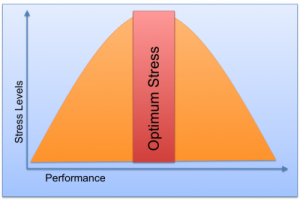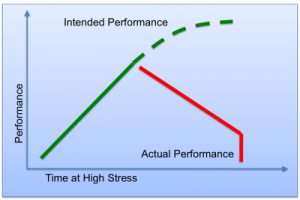There is a close relationship between stress and performance. This relationship can exist in both a negative and positive way. Stress is a stimulus that causes a physiological or psychological effect. Good stress is termed ‘eustress’, while bad stress is termed ‘distress’. Stressors are the circumstances or situations that induce a stress response.
In sport and athletic performance (and in fact, in all levels of life), the relationship between stress and performance is vital in maximising outcomes. This relationship is outlined below.

The region of optimum stress is commonly referred to as the ‘ideal performance state’, or ‘the zone’. If the stress level is too low, boredom is the result. If too high, anxiety results.
Long term and continued stress however has a very different effect on performance, with fatigue, exhaustion, ill health and breakdown. This creates a void between intended performance and actual performance, as outlined below.

Warning signs of long term stress include:
- High blood pressure, heart rate and chest pain.
- Headaches, muscular aches and jaw pain.
- Increased sweating, acne and hives.
- Dry mouth, stomach pain.
- Increase or loss of appetite.
- Impotence or loss of sex drive.
- Insomnia, nightmares or fatigue.
- Nervousness or restlessness.
- Fear, panic, anxiety.
- Irritation and anger.
- Depression.
Stress management techniques include:
- Physical activity (releases endorphins and reduces tension).
- Progressive muscle relaxation.
- Breathing techniques.
- Meditation.
- Better time management strategies.
Take the test below to see how your stress levels rate:
To measure stress according to the Holmes and Rahe Stress Scale, the number of “Life Change Units” that apply to events in the past year of an individual’s life are added and the final score will give a rough estimate of how stress affects health.
| Life event | Life change units |
|---|---|
| Death of a spouse | 100 |
| Divorce | 73 |
| Marital separation | 65 |
| Imprisonment | 63 |
| Death of a close family member | 63 |
| Personal injury or illness | 53 |
| Marriage | 50 |
| Dismissal from work | 47 |
| Marital reconciliation | 45 |
| Retirement | 45 |
| Change in health of family member | 44 |
| Pregnancy | 40 |
| Sexual difficulties | 39 |
| Gain a new family member | 39 |
| Business readjustment | 39 |
| Change in financial state | 38 |
| Death of a close friend | 37 |
| Change to different line of work | 36 |
| Change in frequency of arguments | 35 |
| Major mortgage | 32 |
| Foreclosure of mortgage or loan | 30 |
| Change in responsibilities at work | 29 |
| Child leaving home | 29 |
| Trouble with in-laws | 29 |
| Outstanding personal achievement | 28 |
| Spouse starts or stops work | 26 |
| Begin or end school | 26 |
| Change in living conditions | 25 |
| Revision of personal habits | 24 |
| Trouble with boss | 23 |
| Change in working hours or conditions | 20 |
| Change in residence | 20 |
| Change in schools | 20 |
| Change in recreation | 19 |
| Change in church activities | 19 |
| Change in social activities | 18 |
| Minor mortgage or loan | 17 |
| Change in sleeping habits | 16 |
| Change in number of family reunions | 15 |
| Change in eating habits | 15 |
| Vacation | 13 |
| Christmas | 12 |
| Minor violation of law | 11 |
Now simply add up your scores and rate yourself based on the numbers below:
- Score of 300+: At risk of illness.
- Score of 150-299+: Risk of illness is moderate (reduced by 30% from the above risk).
- Score 150-: Only have a slight risk of illness




